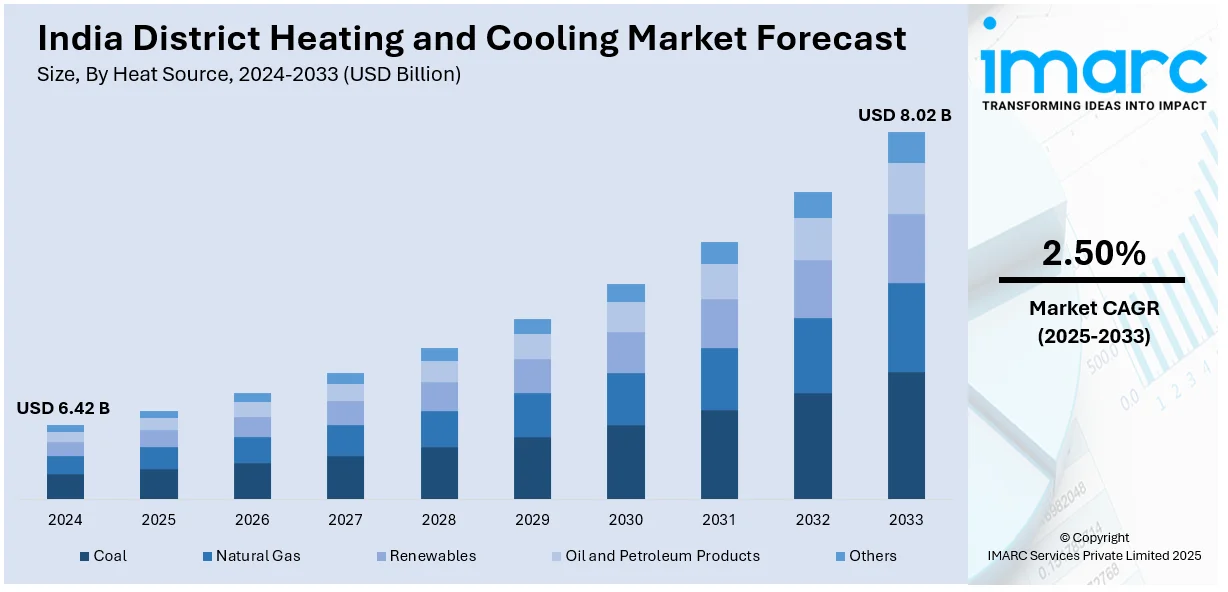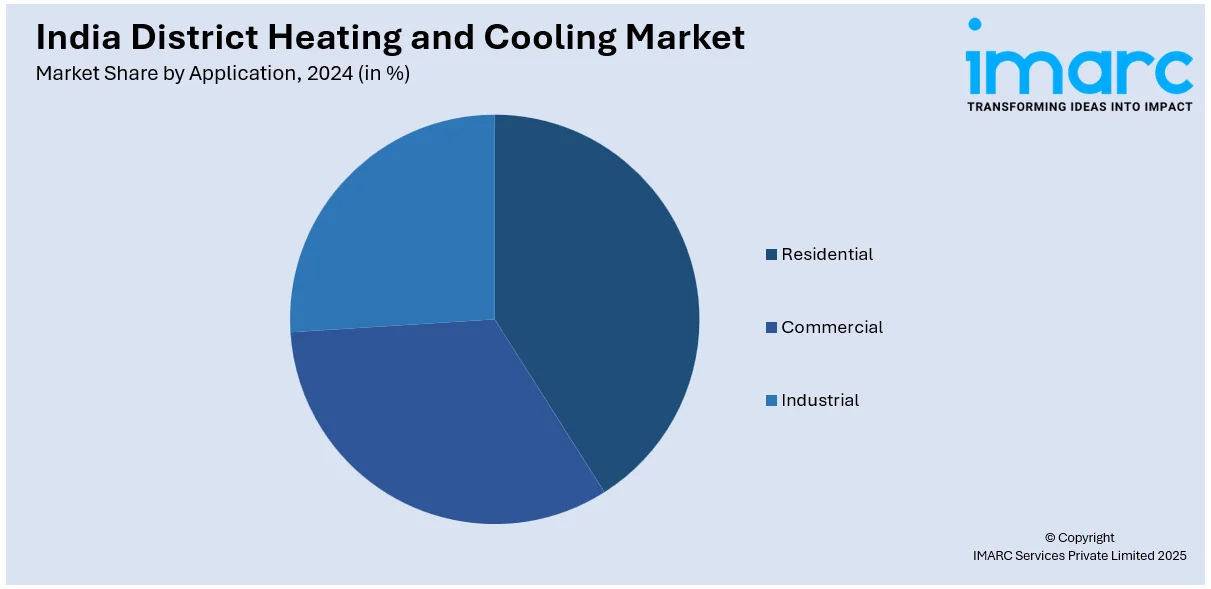
India District Heating and Cooling Market Size, Share, Trends, and Forecast by Heat Source, Application, and Region, 2025-2033
India District Heating and Cooling Market Overview:
The India district heating and cooling market size reached USD 6.42 Billion in 2024. Looking forward, IMARC Group expects the market to reach USD 8.02 Billion by 2033, exhibiting a growth rate (CAGR) of 2.50% during 2025-2033. The market is expanding due to increasing urbanization, energy efficiency initiatives, and the growing demand for sustainable solutions in residential and commercial sectors. Additionally, government policies promoting renewable energy and energy-efficient technologies are driving the market, with a focus on reducing carbon emissions and improving energy security.
|
Report Attribute
|
Key Statistics
|
|---|---|
|
Base Year
|
2024 |
|
Forecast Years
|
2025-2033
|
|
Historical Years
|
2019-2024
|
| Market Size in 2024 | USD 6.42 Billion |
| Market Forecast in 2033 | USD 8.02 Billion |
| Market Growth Rate (2025-2033) | 2.50% |
India District Heating and Cooling Market Trends:
Rising Adoption of Renewable Energy in District Heating and Cooling
India’s district heating and cooling market is increasingly integrating renewable energy sources such as solar thermal, biomass, and geothermal energy. With the government pushing for sustainable urban infrastructure, renewable-based district energy systems are gaining traction. For instance, according to industry reports, India added nearly 15 gigawatts (GW) of renewable energy capacity between April and November 2024 nearly doubling the 7.57 GW added during the same period in the previous year Additionally, solar-powered district cooling plants are especially growing in high-cooling-demand cities, lessening the reliance on traditional electricity-based cooling. Geothermal-based heating systems are also emerging in select regions, offering a long-term, low-carbon solution. Additionally, biomass is contributing towards community-scale district heating, especially in industrial and rural settings. These developments conform to India's net-zero vision and increasing attention to energy efficiency in commercial as well as residential buildings. Besides this, public and private investments are expected to accelerate as clean energy solutions become more cost-competitive.

To get more information on this market, Request Sample
Urbanization and Expansion of District Energy Infrastructure
India’s rapid urbanization is driving the expansion of district heating and cooling infrastructure, particularly in commercial districts, IT parks, hospitals, and residential complexes. For instance, as per industry reports, over 40% of India’s population is projected to reside in urban areas by 2030, reflecting a substantial shift from rural to urban living. Rising energy demands, coupled with the need for efficient space cooling solutions, have led to increased adoption of centralized cooling plants in metro cities. Additionally, new urban projects, including smart cities and mixed-use developments, are prioritizing district energy networks to reduce individual building energy loads. As urban real estate expands, the government is encouraging public-private partnerships (PPPs) to develop large-scale, sustainable district heating and cooling solutions. This trend is set to accelerate with growing demand for energy-efficient infrastructure and stricter environmental regulations promoting low-carbon urban development.
India District Heating and Cooling Market Segmentation:
IMARC Group provides an analysis of the key trends in each segment of the market, along with forecasts at the region level for 2025-2033. Our report has categorized the market based on heat source and application.
Heat Source Insights:
- Coal
- Natural Gas
- Renewables
- Oil and Petroleum Products
- Others
The report has provided a detailed breakup and analysis of the market based on the heat source. This includes coal, natural gas, renewables, oil and petroleum products, and others.
Application Insights:

- Residential
- Commercial
- Industrial
A detailed breakup and analysis of the market based on the application have also been provided in the report. This includes residential, commercial, and industrial.
Regional Insights:
- North India
- South India
- East India
- West India
The report has also provided a comprehensive analysis of all the major regional markets, which include North India, South India, East India, and West India.
Competitive Landscape:
The market research report has also provided a comprehensive analysis of the competitive landscape. Competitive analysis such as market structure, key player positioning, top winning strategies, competitive dashboard, and company evaluation quadrant has been covered in the report. Also, detailed profiles of all major companies have been provided.
India District Heating and Cooling Market News:
- In November 2024, Climaveneta Climate Technologies, part of Mitsubishi Electric, announced an investment in a new plant in Narsapura, India, to expand production of efficient cooling solutions. The facility is set to manufacture chillers, heat pumps, and precision cooling systems to meet growing domestic and international demand, particularly in data centers and commercial sectors.
India District Heating and Cooling Market Report Coverage:
| Report Features | Details |
|---|---|
| Base Year of the Analysis | 2024 |
| Historical Period | 2019-2024 |
| Forecast Period | 2025-2033 |
| Units | Billion USD |
| Scope of the Report |
Exploration of Historical Trends and Market Outlook, Industry Catalysts and Challenges, Segment-Wise Historical and Future Market Assessment:
|
| Heat Sources Covered | Coal, Natural Gas, Renewables, Oil and Petroleum Products, Others |
| Applications Covered | Residential, Commercial, Industrial |
| Regions Covered | North India, South India, East India, West India |
| Customization Scope | 10% Free Customization |
| Post-Sale Analyst Support | 10-12 Weeks |
| Delivery Format | PDF and Excel through Email (We can also provide the editable version of the report in PPT/Word format on special request) |
Key Questions Answered in This Report:
- How has the India district heating and cooling market performed so far and how will it perform in the coming years?
- What is the breakup of the India district heating and cooling market on the basis of heat source?
- What is the breakup of the India district heating and cooling market on the basis of application?
- What is the breakup of the India district heating and cooling market on the basis of region?
- What are the various stages in the value chain of the India district heating and cooling market?
- What are the key driving factors and challenges in the India district heating and cooling market?
- What is the structure of the India district heating and cooling market and who are the key players?
- What is the degree of competition in the India district heating and cooling market?
Key Benefits for Stakeholders:
- IMARC’s industry report offers a comprehensive quantitative analysis of various market segments, historical and current market trends, market forecasts, and dynamics of the India district heating and cooling market from 2019-2033.
- The research report provides the latest information on the market drivers, challenges, and opportunities in the India district heating and cooling market.
- Porter's five forces analysis assist stakeholders in assessing the impact of new entrants, competitive rivalry, supplier power, buyer power, and the threat of substitution. It helps stakeholders to analyze the level of competition within the India district heating and cooling industry and its attractiveness.
- Competitive landscape allows stakeholders to understand their competitive environment and provides an insight into the current positions of key players in the market.
Need more help?
- Speak to our experienced analysts for insights on the current market scenarios.
- Include additional segments and countries to customize the report as per your requirement.
- Gain an unparalleled competitive advantage in your domain by understanding how to utilize the report and positively impacting your operations and revenue.
- For further assistance, please connect with our analysts.
 Request Customization
Request Customization
 Speak to an Analyst
Speak to an Analyst
 Request Brochure
Request Brochure
 Inquire Before Buying
Inquire Before Buying




.webp)




.webp)












